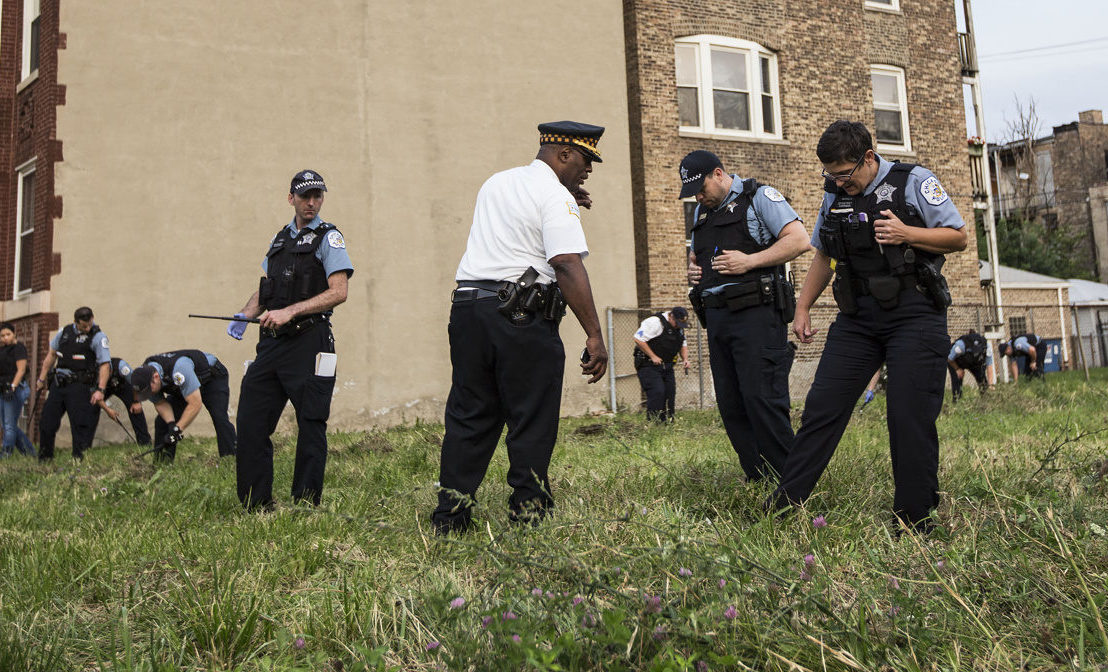Sign up for The Media Today, CJR’s daily newsletter.
FOR FOUR YEARS, WHILE COMMUNITIES on the south and west sides of Chicago fought an ongoing war against street violence—while people wailed and stumbled and somehow mothers and brothers and kindergarten teachers kept going—Jason Wambsgans captured the blood washed in orange light, the broken bodies, the grief.
This year, Wambsgans, a 44-year-old Detroit native, won the Pulitzer Prize for Feature Photography for documenting the intractable violence that has gripped parts of the city. Wambsgans won for his photographs of Tavon Tanner, who was one of 24 children under the age of 12 who were shot last year in Chicago. In the photographs, Tanner, who is now 11 years old, recovers from a gunshot wound to his shoulder. In one image, Tanner tears up before surgery at Lurie Children’s Hospital to remove the bullet. In another, he dances with his cousins. In the portrait of Tanner that ran on the front page, a picture Wambsgans calls “one of the most beautiful I will ever make,” the boy pulls up his shirt, revealing his scar.
“Tavon lived a mile and a half from me,” Wambsgans says. “The injustice, the segregation in the city is sickening.”
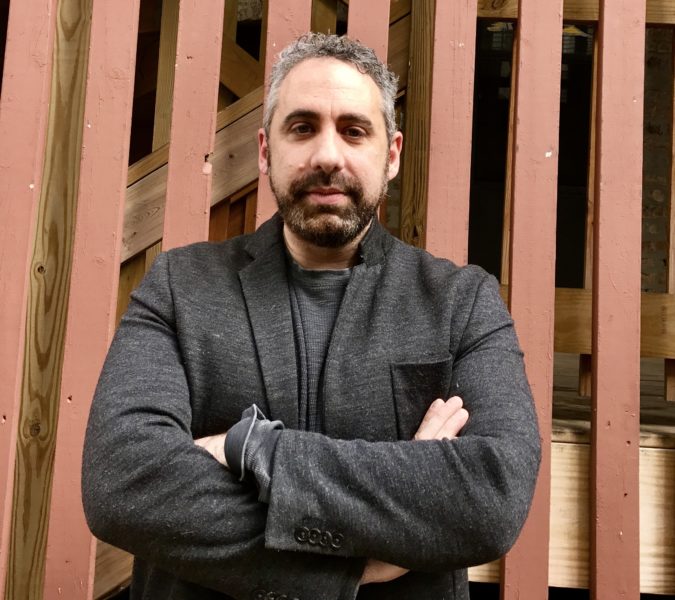
Jason Wambsgans, Chicago Tribune photographer and winner of this year’s Pulitzer Prize for Feature Photography. Photo by Jackie Spinner.
Photojournalists like Wambsgans—conflict photographers on the frontlines of their own streets, in their own cities, capture the intersection of guns and police, and poverty and race. At many of the crime scenes he documented, Wambsgans and Tribune overnight reporter Peter Nickeas sometimes showed up before the police did. They stayed for hours, witnesses to horrors that have defied Chicago city officials and community leaders. “Sometimes we will stand there for three or four hours if nothing is happening, waiting for something to reveal itself in a subtle way,” Wambsgans says.
As he documents Chicago’s violence, a worry nags Wambsgans: Is he helping or hurting? He feels guilty, he tells CJR. He is not alone. Many photojournalists who document violence on their city’s streets find themselves wrestling with the same question. It tails them each time they race to a crime scene, or knock on a door, or return from a funeral with a memory card filled with images. To what end?
“All of them wonder why they keep showing people this violence and nothing changes and things seem to be getting worse—or at least that’s the public perception,” says James Kelly, a photojournalism scholar and associate professor of journalism at the Media School at Indiana University. “There hasn’t been a large social movement to correct the problem. Society hasn’t responded the way society responded to photographic coverage of the war in Vietnam or poverty in Appalachia.”
It hasn’t responded like it did when the late American photojournalist Chris Hondros photographed a five-year-old girl after her parents were shot dead by US soldiers at a checkpoint in Iraq in 2005. His iconic pictures instigated a change in the military’s rules of engagement with civilians and brought the civilian cost of war home to Americans.
Wambsgans, covering his own war on the streets of Chicago, has seen little but grief. When he and Tribune writer Mary Schmich were trying to find parents willing to talk for the story that eventually focused on Tavon Tanner, parents would quickly shut down. Wambsgans remembers someone asking once, “What’s the point of this?” Schmich, he recalls, had no answer.
“I have to fight myself from talking out of the benefit of doing this,” Wambsgans says. “And then after the story runs and you get [a] response from the people, you think maybe this really can.”
“Can what?” I ask.
“Change people’s minds about these issues or just let them walk in somebody’s shoes.”
AS A PHOTOJOURNALIST WITH THE Chicago Sun-Times for 24 years, Jon Sall saw his share of violence. “I always struggled with my role as a journalist to document and inform, and did my work with the intent that it could make a difference in the world,” he says.
Then Lee McCullum, Jr. was killed, and now Sall isn’t so sure if his work has done anything at all.
McCullum was one of the subjects of the 2014 CNN documentary Chicagoland, for which Sall was a cinematographer. Over eight episodes, Chicagoland follows the young student leader and his struggle to get out of a relentless cycle of poverty and gangs with help from his principal at Fenger Academy High School, Elizabeth Dozier. McCullum was the prom king, an Honor Roll student, and graduated with his class in early 2013. Dozier lined up a job for him, and was encouraging McCullum to attend college.
Understanding different language or cultures can be difficult enough when covering a story, but when such a level of violence is involved, it amplifies difficult situations.
During the filming, McCullum “disappeared,” Sall recalls, going into hiding outside of the city because he was afraid his gang association had caught up with him. The Chicagoland producers discovered where he was staying, and Sall went to meet with him and film him.
“I filmed Lee as he confessed to Principal Dozier that he needed to be out of Chicago and surround himself with positiveness,” Sall says. “Lee promised Principal Dozier that he would take her up on her offer to arrange for Lee to go away to school, and get away from Chicago.”
McCullum was shot and killed on May 12 last year, on the South Side of the city.
Sall was on vacation in Peru at the time. The news of McCullum’s death hit him with a profound sadness that he isn’t sure he can explain. “While I was filming Lee talking with Principal Dozier as he was hiding out downstate, I really thought that he was sincere about turning his life around and starting new,” he says. “I cannot claim to understand the forces at work in Lee’s situation, but the news of his death affected me differently than all the other random violence aftermath that I have witnessed over the years.”
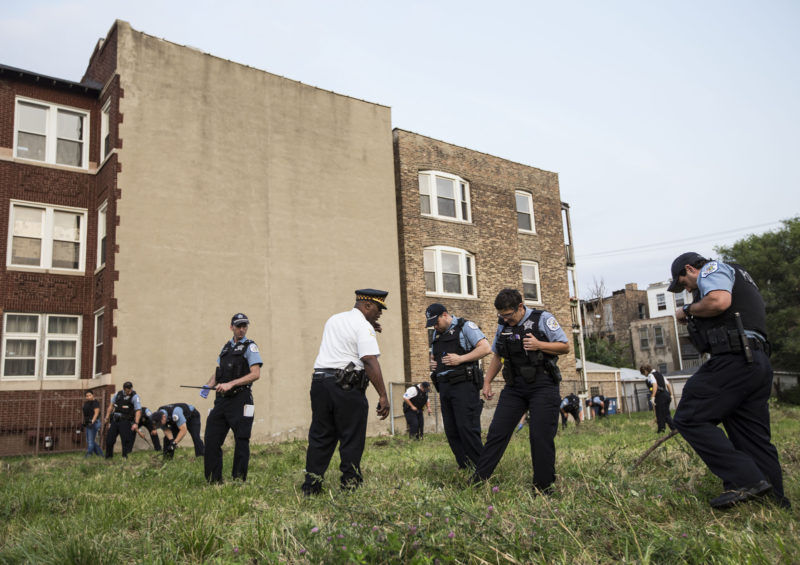
Chicago police search for shell casings near where 11-year-old Shamiya Adams was killed by a stray bullet during a sleepover. Photo by Alex Wroblewski.
Alex Wroblewski, who covered the city’s violence for the Chicago Sun-Times on and off in 2014, says his need to understand why the violence continues—why so many young people like McCullum can’t escape it—draws him back to the story of violence all over the world.
“I felt like it’s an important story, issue, epidemic that hundreds of people are losing their lives to, and I feel like readers in Chicago were numb to that,” says Wroblewski, who interned at The New York Times last summer and is now working as a freelance photographer in New York. “Another day, another shooting. And on a national level it got even less attention. It was something I didn’t want to ignore, something I wanted to understand.”
He says photographing violence in Chicago prepared him in an unexpected way for documenting violence in other parts of the world, including the ongoing war in Iraq, which he covered in 2015.
“From the streets to funerals to the kitchens of mothers who lost sons, it gave me experience with understanding and communicating with people,” he says. “Understanding different language or cultures can be difficult enough when covering a story, but when such a level of violence is involved, it amplifies difficult situations. It may have gave me a different sense of being able to understand people and their emotions, being about to explain why I’m doing what I do with my camera, and hopefully drawing attention to the story, hoping it makes a difference.”
LIKE MOST NEWS OUTLETS, the Tribune has guidelines for what images or video it will publish. Robin Daughtridge, the paper’s associate managing editor for photography, says editors and producers ask themselves what the news value is, whether the images or video fairly represent the story, and what the impact will be on the audience. Each story, photograph and video is unique and treated individually, she says.
“Tribune photographers have teamed with reporters to bring readers closer to the scenes of violence and, hopefully, to some understanding of the root causes,” she says. “Without information, education and empathy, how can people relate to those living alongside the shootings and gang activity? Unless journalists expose problems in society, we’ll never be able to address them.”
Even if the coverage has not stemmed the violence, it has depicted it with honesty and intimacy. In this video from Wambsgans, he documents two sisters who dragged their sons out of bed in the middle of the night to see a teenage body in the street. (The Tribune cautions that the video contains “graphic images and language.”)
“This little boy, he was probably 14 or 15, but he looked 10, laying on the curb,” Wambsgans says. “That part I will never forget. His baby fat laying in the street. We talked to his older brother who was 16 but could have been 40. He had to come identify his brother for his whole family. We knew that was a powerful part. So gradually everybody left. So we stayed there and stayed there.”
That’s when the two sisters came out. It was an unscripted moment, emotionally naked and humanizing. Two mothers, angry and scared, lecture their sons. The boy’s body is in the distance, covered by a white sheet.
“There’s a lot of pictures I won’t take,” Wambsgans says.
“Because you are afraid they won’t run them?” I ask.
“Because I’m afraid they will run them.”
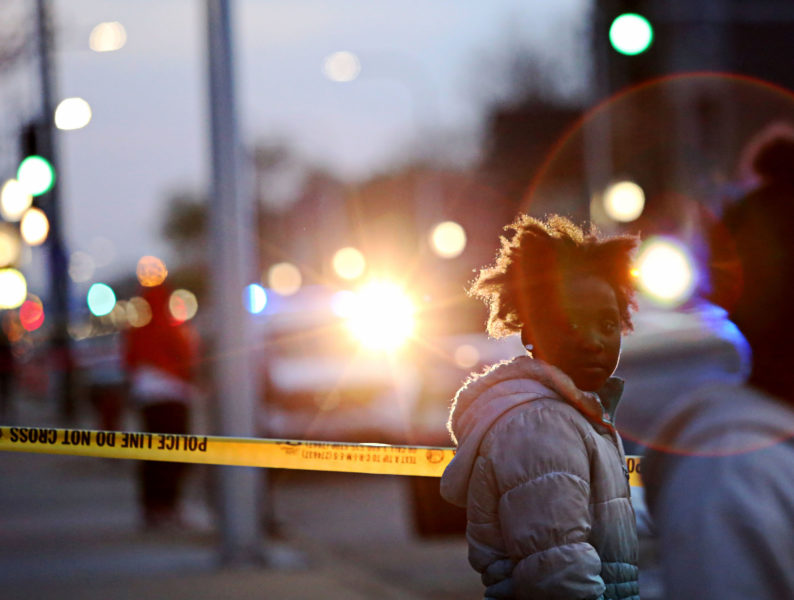
A young girl walking home encounters a crime scene where two people were shot at West 59th Street & South Morgan Street in Chicago on May 5, 2014. Photo by Alex Wroblewski.
IN A PUBLIC LECTURE ABOUT HIS WORK on Tuesday night in Chicago, Wambsgans told an audience that many of his images depict children who are living with the violence. Even though he has captured dozens and dozens of crime scenes, he still looks for the unexpected. He tries to carry himself respectfully and discreetly, he says. He and his reporting partners park the car where they can make a quick escape if things become too dangerous. They scan the crowd for potential trouble. A soft-spoken, reflective man, Wambsgans says he has learned not to act timid because people can perceive it as disrespectful. If he acts afraid, what does that say to a community with no choice but to live with fear?
For a recently published story about gang violence in the Little Village neighborhood of Chicago, Wambsgans says he spent weeks hanging out without ever taking a picture. It paid off. His photos and video from the two-year project display an intimacy that comes only when the people being documented forget the photographer is there.
Anthony Soufflé also worked on the overnight shift, one of the photographers in the rotation with Wambsgans. He spent four years at the Chicago Tribune, much of that time documenting violence. He left the paper and the city last year to take a job as a staff photographer at the Minneapolis Star Tribune. Minneapolis had 37 homicides last year, compared to a record-breaking 762 murders in Chicago.
“My last year there, I asked not to do it,” Soufflé says. He elaborates:
“When you first go out to do it, it’s new, it’s a little scary, it’s a little exciting, you aren’t exactly sure what you are doing. You go to enough of these things and it becomes a play you’ve seen before. I just remember the last time I did it, as we were winding down for the year, I just remember I didn’t want to be doing it at all. I was almost like, ‘I’m going to go sit at home and I’ll listen to the scanner and watch Twitter, but I’m not going to go sit out there and wait for stuff.’ There were other things I wanted to focus on.”
When the Tribune first started the overnight rotation in 2013, the paper had five photographers who each spent a week on overnights and then had four weeks off. That schedule later changed to one week on and only three weeks off. It took its toll, Soufflé says, even as the staff was assembling an incredible visual chronicle of what was happening on the streets of Chicago.
“It was hard to leave Chicago,” Soufflé tells CJR. “It was hard to leave the Tribune. That city. That life. But it’s super self-destructive, or it can be. The job we were doing and the time we were living there, it wasn’t healthy.”
I asked Daughtridge, the Tribune’s AME for photo, what safeguards the paper has in place to watch photographers for signs of post-traumatic stress.
“Working the overnights is on a voluntary basis, so when a photographer wants to rotate off that shift, we honor that,” she says. “Every year since 2013, people have cycled in and out of the team. A lot of discussion takes place before we kick into the overnight rotation in late spring, and those conversations are ongoing, whenever and wherever people need to have them.”
The people continually getting murdered look like me. It took an emotional toll continually seeing people’s lives get torn apart.
Like Soufflé, after a few years of unrelenting coverage of the violence, Wambsgans asked for a break, which he got. He took over in the food studio for a while and documented pills for colleague Sam Roe’s investigative series on dangerous drug interactions, which was a finalist for the Pulitzer this year. After a few months, Wambsgans got an email from the assignment editor asking him to come back on the rotation, he recalls. His heart started pounding. “It was just an email,” he says. “I was like a caged animal. The week leading up to it, I was trembling.”
Then he was in the car, out on the streets, waiting for that first call that something had happened. It came. He slammed a Red Bull. He showed up on the scene and jumped out of the car. “This plain calm washes over me,” he says.
Heather Charles, who was a staff photographer at the Tribune from 2009 until 2014, was never assigned to the overnight shift but often documented the aftermath during the morning shift, she says.
Charles, who is black, says it was hard for her not to take the violence personally. “Covering violence in Chicago became extremely difficult for me because so much of it was focused in the African-American community,” she says. “The people continually getting murdered look like me. It took an emotional toll continually seeing people’s lives get torn apart.”
She eventually walked away from daily journalism. “I think it’s important for people to know what’s going on, but at some point we have to do something about it,” she says. “Because I took it so personally, I couldn’t figure out the importance of covering the violence. It hit too close to home.”
Charles now teaches photography and videography to students in sixth through 12th grade in the Oakland public school system in California.
“I kept asking myself why I was doing it and eventually decided that the best way to make an impact in these communities was to start working and volunteering in them and engaging youth,” she says. “I remember seeing kids walking to school, walking by bodies that are still there. They need help processing that.”
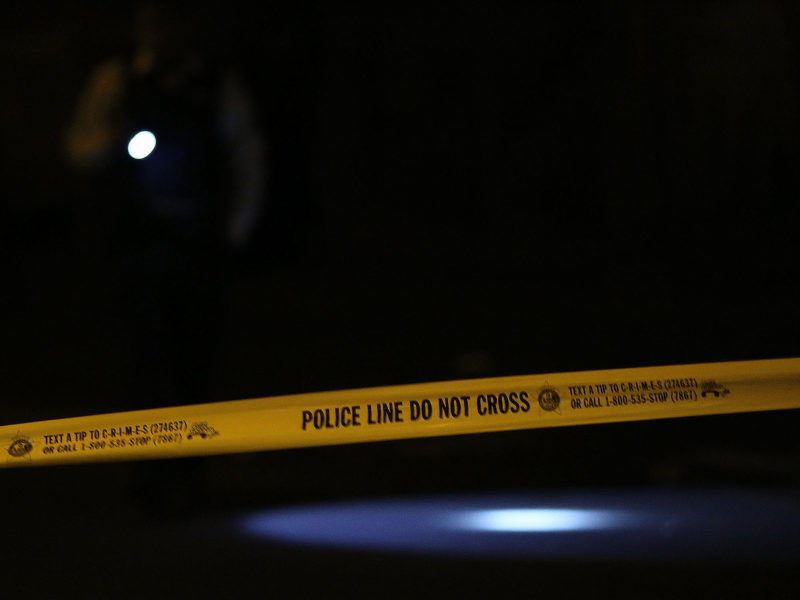
Police investigate the scene where a 22-year-old man was shot in the 7200 block of South Perry Avenue in Chicago on Saturday, April 19, 2014. Photo by Alex Wroblewski.
IN THE WEEKS SINCE HIS PULITZER win, Wambsgans can’t stop thinking about another story, about a tornado. In 2005, the Tribune’s Julia Keller won a Pulitzer Prize for Feature Writing for her coverage of a tornado that ripped through the town of Utica, Illinois, killing eight people. Wambsgans, who had only been at the paper for a few years then, photographed the devastation.
He remembers going back to Utica after Keller won the Pulitzer and meeting a family who had been part of the story. They greeted him like a lost relative. Their story had been entwined with that of the Tribune journalists. They didn’t want to lose the connection.
Wambsgans doesn’t want to forget Tavon Tanner, especially now that he’s won the Pulitzer. He’s almost desperate not to, he explains over coffee in a northside neighborhood where he used to live. On the day the prize was announced, Wambsgans was holed up in an office in the newsroom, editing photos from an assignment earlier that day. He walked out of the office to cheers from colleagues. Schmich, who won a Pulitzer herself in 2012 for commentary, hurried over with a phone and thrust it at him, he recalls. It was Mellanie Washington, Tanner’s mother.
Even though Wambsgans knows that documenting the city’s violence has changed him in profound ways, he doesn’t want to stop. “I can create a little bit of understanding in different parts of the city,” he says. “It’s the one thing the camera can do.”
Has America ever needed a media defender more than now? Help us by joining CJR today.



